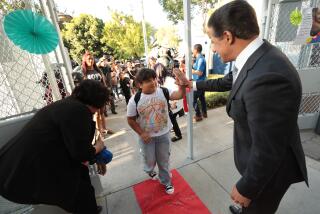Latino Students Racially Isolated in Schools, Study Says
- Share via
Latino students in Orange and Los Angeles counties are more likely to attend school in a racially isolated setting than in any other major metropolitan areas in the West, according to a study released Monday by the University of Chicago.
Based on federal school enrollment data from 1968 to 1984, the study said the segregation experienced by Latino youngsters nationwide will worsen unless schools make strong and systematic efforts to reduce it through such methods as changing school boundaries or busing.
“There has been almost no serious effort to desegregate” schools where Latino students are concentrated, said University of Chicago political science professor Gary Orfield, who, as director of the National School Desegregation Project, was the principal author of the report. “The federal government has made no significant effort, the states have made no major effort, and Hispanic groups haven’t worked very hard on it.”
Orfield analyzed information on 32,000 schools collected by the U.S. Department of Education. He said the study provided clear signs of the “deepening isolation of children growing up in inner-city ghettos and barrios from any contact with mainstream American society.”
Out of 15 metropolitan areas in the West with more than 50,000 students, the segregation of Latino pupils increased the most dramatically in Los Angeles, followed by Orange County, where Orfield’s analysis of enrollment information from the Anaheim, Santa Ana and Garden Grove schools showed the average Latino student in 1984 attending a school that was 31% Anglo, compared to 1970 when the figure was 73%.
And the isolation is getting worse in Orange County.
The latest figures in the Santa Ana Unified School District, for the 1986-87 school year, indicate that Anglo and other minorities account for just over 26% of total enrollment, according to Joan Wilkinson, clerk and former president of the district’s board of education. Based on current elementary school enrollments, Wilkinson said, black and Asian-Pacific school populations in the district are decreasing along with Anglo enrollments.
“The whole issue of segregation seems moot when you have numbers like that,” Wilkinson said in an interview. “These statistics are not particularly relevant.” Finding “enough classrooms to put our kids in” is “where our challenge is,” she said, along with increasing the students’ proficiency in the English language.
Of the 15 Western metropolitan areas, schools in the greater Los Angeles area were the most likely to isolate Latino students in predominantly minority schools. In 1984, the last year for which figures were available, the average Latino student in Los Angeles attended a school that was only 17% Anglo, compared to 1970 when the typical Latino pupil attended a school that was at least 45% Anglo.
Similar declines in the level of integration were found in San Diego and the San Francisco-Oakland area.
Nationally, the highest level of Latino segregation was found in schools in New York state, where 85% of Latino students--primarily Puerto Ricans--attend predominantly minority schools. California was sixth on the list, with 74% of Latino students attending predominantly minority schools.
Orfield said the deepening isolation of Latino youngsters in public schools is due primarily to the rapid growth of the Latino population and its concentration in a few large metropolitan areas. School enrollment of Anglos declined 19% nationwide between 1968 and 1984, and black enrollment has changed slightly, increasing by 2%, he said. Latino enrollment, however, has grown by 80% over the same period.
“You would automatically have an increase in segregation (of Latino students) unless something was done to offset it,” he said.
Orfield found some important regional changes in the segregation of black students but little improvement overall. In California he noted a drop in the proportion of blacks in racially isolated schools to 35% from 41% between 1980 and 1984. Of large Western metropolitan areas, however, Los Angeles and San Francisco had the highest levels of segregation of black pupils.
On the other hand, Southern states that once practiced “absolute segregation” under state laws requiring racial segregation were found to have the highest levels of integration nationwide, the study said.
Times staff writer Mark I. Pinsky contributed to this story in Orange County.
More to Read
Sign up for Essential California
The most important California stories and recommendations in your inbox every morning.
You may occasionally receive promotional content from the Los Angeles Times.











